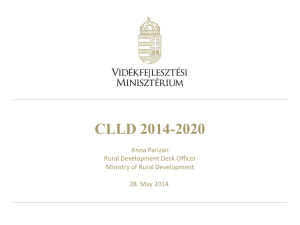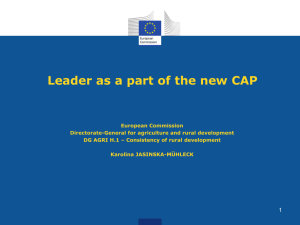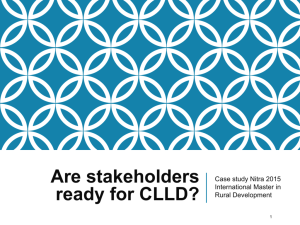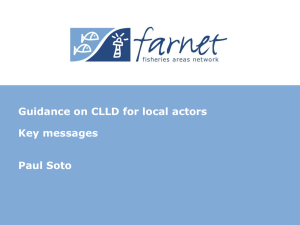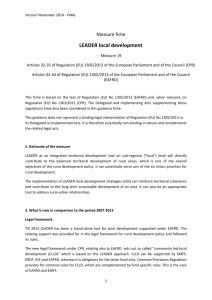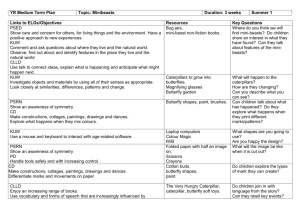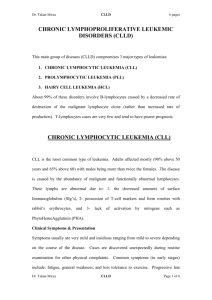Mr. M. Majerech
advertisement
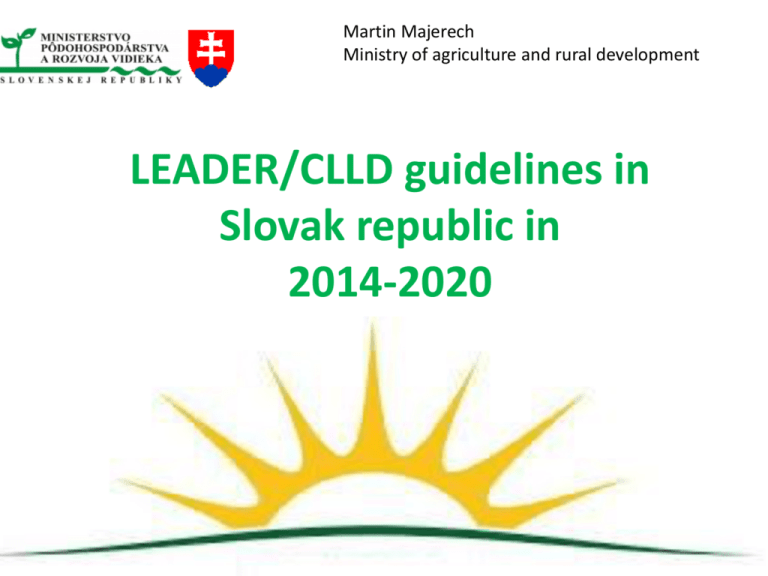
Martin Majerech Ministry of agriculture and rural development LEADER/CLLD guidelines in Slovak republic in 2014-2020 Presentation focus on: LEADER in 2007-2013 Basic information about implementation of LEADER in EU / Slovakia LEADER/CLLD in 2014-2020 Process of programming, legislation and strategic documents SWOT analysis LEADER/CLLD in programming documents LEADER/CLLD guidelines CLLD management system CLLD strategy template 2 LEADER in 2007-2013 – what is the LEADER approach Innovative approach for rural development, method how to develop an area, how to search new potential Bottom – up approach Local action group (LAG) – public private partnerships, it consists of at least 50% of the private and civil sector Local development strategies – description of the problems and the ways how to solve them History LEADER I (1991 - 1993) LEADER II (1994 - 1999) LEADER + (2000 - 2006) 2007-2013 – part of the rural development programmes (RDP) 2014-2020 – part of the rural development programme + CLLD 3 LEADER in 2007-2013 – EU level LEADER as part of the RDP– axis 4 Possibility to implement objectives and measures of other 3 axes Different approach in member states (MS) All 3 axes (18 MSs) The 1st and 3rd axis (Denmark, Greece, Estonia, Latvia) Only the 3rd axis (Portugal, Slovakia, Lithuania, Poland, Ireland) Financial allocation – min. 5 % EAFRD allocation (2 - 2,5 % new MS) 2 – 3 % - Bulgaria, Romania, Slovakia, Cyprus ... 10 - 11 % - Denmark, Estonia, Ireland, the Netherlands, Portugal, Spain 4 LEADER in 2007-2013 – EU level Overview of axes, where measures are implemented by LEADER approach in particular member states Proportion of individual axes in RDP in % according to MS 5 LEADER in 2007-2013 – in Slovak republic 1st period, no experience (only technical assistance SAPARD – established development strategies in 11 territories of SK) Implementation of the axis 3 3,13 % from the EAFRD, 79 013 206 EUR (EAFRD +NB) 6 LEADER in 2007-2013 – LAGs selection 2 calls for proposal Ist call – announced on 4th April 2008, receipt of applications in period 1st– 15th of december 2008 IInd call – announced on 30rd October 2009, receipt of applications in period 15th – 29th of january 2010 Evaluation of applications and selection procedure of LAGs Administrative check– paying agency (PA) Formal check of completeness of applications and strategies Monitoring the eligibility of actions and eligibility criteria Selection Committee – Managing authority (MA) External evaluators – eligibility criteria of LAG, qualitative evaluation of strategies Sorting by points, eventually 3rd evaluator (if the difference in evaluation is more than 20 points) 7 LEADER in 2007-2013 – LAGs selection Profil of average LAG in SK Basic data about LAGs Population Area km2 Density of popul./km2 21 298 311,2 78,96 Number of LAGs Number of municipa lities Number of municipalities in % of SK Populat ion of LAGs Population in % of SK 29 543 18,8 617 633 11,44 Area of LAG km2 Area of LAG in % of SK 9 023,59 18,4 8 Programming period 2014-2020 – legislation EU Common strategic framework – regulation (EU) No 1303/2013 of the European parliament and of the Council of 17 December 2013 Common provision on 5 funds European Regional Development Fund (ERDF) European Social Fund (ESF) European Agruculture Fund for Rural Development (EAFRD) Cohesion Fund (CF) European Maritime and Fisheries Fund (EMFF) Community-led local development – CLLD – articles 32-35 Article 32 – CLLD Shall be supported by EAFRD (as LEADER) and may be supported by the ERDF, ESF, EMFF Article 33 – CLLD strategies Article 34 – Local Action Groups (LAGs) – tasks and responsibilities Article 35 – support from CLLD shall cover: Preparatory support Implementation of operations under CLLD strategy Preparation and implementation of the LAGs cooperation activities Running cost and animation Regulation for Rural Development – regulation (EU) No 1305/2013 of the European parliament and of the Council of 17 December 2013 Support for rural development by the EAFRD LEADER – articles 42-44 Article 42 – LEADER LAGs Article 43 – LEADER stuart-up kit – specific „preparatory support“ and support for small pilot projects – optional Article 44 – LEADER cooperation activities 9 Programming peridod 2014-2020 – strategic programming documents EU level Position paper – main priorities for each MS from the view of the EU National level Partnership agreement Main priorities for all EU funds in SK CLLD – chapter 3.1 – CLLD supported by EAFRD (Rural development programme) and EFRD (Integrated regional operational programme) – mutlifunded CLLD strategy (1 LAG – 2 funds) Operational programmes / Programmes Rural development programme – measure 19 LEADER Integrated regional operational programme – priority axis 5 CLLD 10 LEADER/CLLD in 2014-2020 – what has 07-13 brought? What is necessary to improve? Strenghts Bottom – up approach Strengthening of subsidiarity Involvement of the private, civil and non-profit sectors into decision making Building of the localpatriotism The rediscovery of regional (local) traditions, products Development of tourism, agro-tourism Investments in areas Increasing interest in public affairs Cooperation Weaknesses Possibility to implement only axis 3 through LEADER Restricted group of beneficiaries No experience with LEADER in Slovakia Poor cooperation in areas, LAG´s/MA/PA Long process of evaluating applications 11 LEADER/CLLD in 2014-2020 – what has 07-13 brought? What is necessary to improve? Opportunities Development potential of the area and residents Contributing to the improvement of the economic development of Slovakia, to create jobs ... The involvement of a broad public, of young people into decision-making Threats Low finance allocation for LEADER Restrictions for LEADER (LAG´s) Bad cooperation, communication 12 LEADER/CLLD in 2014-2020 – main changes CLLD – 2 funds, 2 programmes Increase of money –205 mil. EUR (from 79 mil. EUR) Number of LAG – min. 50 (from 29) Population cover – min. 1 000 000 inhabitants (from 500 000) Much more possibilities More measures, more type of beneficiaries Bigger flexibility – not only few measure, not only measure and condition from RDP, but also possibility to go outside of RDP 13 LEADER/CLLD in 2014-2020 – CLLD in programmes CLLD – 2 funds, 2 programmes Integrated regional operational programme (IROP) – ERDF Priority axis 5 – Community led local development Specific objective 5.1.1 – support for businesses Specific objective 5.1.2 – public services, support for rural-urban linkages 100 mil. EUR Rural development programme (RDP) – EAFRD – as LEADER measure Measures from regulation EU 1305/2013, except „non project“ measures Beneficiaries – farmers, agri holdings, forestries, municipalities etc. 105 mil. EUR 4 submeasures Preparatory support Implementation of strategies Cooperation projects Running costs and animation 14 Programming period 2014-2020 – LEADER/CLLD guidelines CLLD managment system CLLD strategy template 15 CLLD management system - content 1. Introductory provisions – definitions, LEADER principles 2. Common provisions fo CLLD management system – – – 3. 4. 5. 6. Common provisions for RDP and IROP – chapters 1-6 a 12 Provisions only for RDP – chapters 7-10 Provisions only for IROP – chapter 11 EU/SK legislation CLLD – provisions from Partenrship agreement SR, coordination on the national level Conflict of interests Local action groups 1. Definition, establishment, task and responsibilities 2. Bodies of LAG – general assembly, executive body, selection committee, manager, statutory representative, revision committee 3. Financing of running and animation costs 4. Selection of LAGs 5. Financial alocation for LAG 7. CLLD in RDP 8. Selection of projects 9. 10. Monitoring 11. CLLD in IROP 12. Changes and amendments of CLLD management system 16 CLLD management system – definitions, LEADER principles 1. LEADER – – – – Innovative approach for rural development, method how to develop an area, how to search a new potential Main principle is bootom-up app Implemented by local actin gorups History • • • • • LEADER I (1991 - 1993) LEADER II (1994 - 1999) LEADER + (2000 - 2006) 2007-2013 – part of the rural development programmes (RDP) 2014-2020 – part of the rural development programme + CLLD 2. 7 principles 1. 2. 3. 4. 5. 6. 7. area-based local development strategies intended for well-identified subregional rural territories; local public-private partnerships (hereinafter local action groups); bottom-up approach with a decision-making power for local action groups concerning the elaboration and implementation of local development strategies; multi-sectoral design and implementation of the strategy based on the interaction between actors and projects of different sectors of the local economy; implementation of innovative approaches; implementation of cooperation projects; networking of local partnerships. 3. CLLD – community led local development, – – – Based on LEADER principles EAFRD as mandatory, other funds optionaly in SK– RDP and IROP 17 CLLD management system - EU/SK legislation 1. EU 1. 2. 3. 4. 5. Regulation (EÚ) No 1303/2013 – common provisions for all ESIF funds Regulation (EÚ) No 1305/2013 on support for rural development by the EAFRD Regulation (EÚ) No 1301/2013 for EFRD Commision Delegated regulation No 807/2014, which supplement regulation (EU) No 1305/2013 Commision implementing regulation No 808/2014, laying down rules for the application of Regulation (EU) No 1305/2013 2. SK 1. Law No 292/2014 on grants from ESIF 2. Law No 83/1990 on association of citizens 3. Law No 25/2006 on public procurement 18 CLLD management system – Local action groups LAGs 1. LAG is group of representatives of public and private local socio-economic interests, in which, at the decision-making level neither public authorities, nor any single interest group represents more than 49 % of the voting rights 2. Legal form of LAG – civic association according the law No 83/1990, which has had approved CLLD strategy (by ministry) 3. Approval of LAG – selection process in selection committee 4. Bodies of LAG – – – – – – general assembly, executive body, selection committee, manager, statutory representative, revision committee 19 CLLD management system – tasks and responsibilities of LAGs 1. designing and implementing the CLLD strategies 2. building the capacity of local actors to develop and implement operations including fostering their project management capabilities; 3. drawing up a non-discriminatory and transparent selection procedure and objective criteria for the selection of operations, which avoid conflicts of interest, ensure that at least 50 % of the votes in selection decisions are cast by partners which are not public authorities, and allow selection by written procedure; 4. ensuring coherence with the CLLD strategy when selecting operations, by prioritising those operations according to their contribution to meeting that strategy's objectives and targets; 5. preparing and publishing calls for proposals or an ongoing project submission procedure, including defining selection criteria; 6. receiving and assessing applications for support; 7. selecting operations and fixing the amount of support and, presenting the proposals to the body responsible for final verification of eligibility before approval; 8. monitoring the implementation of the CLLD strategy and the operations supported and carrying out specific evaluation activities linked to that strategy. 20 CLLD management system - selection of LAGs 1. When selecting MAS framework will be applied following criteria for selecting strategies : General criteria for LAG Quality of partnership Quality of CLLD strategy 2. Ministry will publish call for proposals on the website LAG will submit CLLD strategy and selection criteria for the selection of operations, 3. Assessing aplication (CLLD strategy and criteria for the selection of operations) by evaluators according to the scoring criteria, 4. Selection committee will make ranking and make protocol from selection 5. Depending on financial limit the selection committe will decide about number of selected LAGs 21 CLLD management system - selection of LAGs - General criteria for LAG a) Number of inhabitants 10 000 – 150 000, b) Inhabitants density max 150 inh/km2, c) Minimum number of municipalities in LAG is 7, d) LAG shall have legal form – civic association according the law No 83/1990, e) LAG shall have created mandatory bodies general assembly, executive body, selection committee, manager, statutory representative, revision committee f) LAG shall be group of representatives of public and private local socio-economic interests, in which, at the decision-making level neither public authorities, nor any single interest group represents more than 49 % of the voting rights g) Members of LAG shall be from LAG area (residence , office or operation), h) Part of LAG can be also cities bigger than 20 000 inhanitants, but those can´t be a beneficiary of projects, i) LAG must have designed the CLLD strategy with clear objectives and measures j) Area of LAG shall be contiguous (municipalities must be connected with their areas) k) Strategy designed by LAG shall be CLLD strategy – created as multifunded – both funds EAFRD and EFRD 22 CLLD management system - selection of LAGs – quality of partnership 1. Building of partnership – How the partnership has been build, who are the members, 2. Community involvement – How the community (inhabitants, businesses, NGO..)has been involved into the process of building partnership and CLLD strategy questionaries, workshops, seminars, interviews, campaigns.. 3. Quality of the LAG management – qualifications and experience of the LAG management 23 CLLD management system - selection of LAGs – quality of CLLD strategy 1. Assessment of analysis 2. Assessment of the strategic framework – vision, priorities, objectives, innovative and integrated characters 3. Assessment of the impementation framework – action plan (measures) 4. Monitoring and evaluation of the CLLD strategy, 5. Assessment of the financial framework 6. Contribution to the improving of the local economy growth 7. Contribution to the RDP and IROP objectives 8. Contribution to the social inclusion 9. Contribution to the climate change and environment 10.Synergies and complementarities 24 CLLD management system – financial alocation for LAG 1. Different alocation for different LAG - FIX + flexible part 2. FIX part – 2.8 mil. EUR per each LAG 3. Flexible part – combination of the criteria as No of inhabitants, No of municipalities, area covered and unemployment rate, – For each criteria is fixed individual amount / EUR – Maximum for flexible part is 1.2 mil EUR 4. Maximum per LAG – 4.0 mil. EUR 25 CLLD management system - selection of the projects implementing in LAG 1. Level of LAG – LAG publish call for proposals – Assesment of the projects – selection criteria, LAG selection committee – Protocol of the selected projects – is send to the paying agency/ministry 2. Level of paying agency/ministry – – – – Formal check Assesment of the porcess made by LAG - decision Contract with final beneficiary Paying to the final beneficiary 26 CLLD strategy template Introduction - summary 1. Basic data of LAG 1. LAG identification data 2. a definition of the area and the population covered by the strategy 2. Building of partnership, history and community involvement 3. Analysis 1. analysis of the area 2. SWOT analysis 3. needs assessment 4. Strategic framework 1. Designing of the vision and the strategic objective 2. Designing of the priorities, specific objectives and measures 3. Intervention logic 4. Integrated characters of the CLLD strategy 5. innovative characters of the CLLD strategy CLLD strategy template 5. Implementation framework 1. managing and implementiation process 1.Organization structures of the LAG – LAG bodies 2.Implementiation process 2. Action plan 3. monitoring and evaluation of the CLLD strategy 1.Description of the monitoring and evaluation methods 2.Monitoring indicators 6. Financial framework – financial plan 7. Contributions of the CLLD strategy, its synergies and complementarities 1.Contribution to the improving of the local economy growth 2.Contribution to the RDP and IROP objectives 3.Contribution to the social inclusion 4.Contribution to the climate change and environment 5.Synergies and complementarities Thanks for attention
